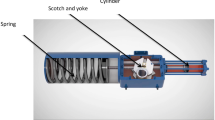Abstract
Three different design parameters of magnetic fluid seal are optimized for the maximum pressure differential capacity of the seal. The program finite element method magnetics (FEMM) based on finite element method is used to find the magnetic flux inside the gap for all the combinations of the design parameters. The data are analyzed using the MINITAB statistical analysis software. The multivariable regression analysis technique is used to find the percentage effect of different parameters and also the optimized dimensions. The effect of magnetic fluid volume on maximum pressure differential capacity of a seal is observed, and the optimized volume is found. The results provide enough data to design and fabricate the seal. This seal can be used in positive as well as negative pressure applications. For example, as vacuum rotary shaft seal in low-pressure chemical vapor deposition machines, pressure seal for stirrer shaft in chemical process chambers to seal toxic gases. This seal can also be used as an exclusion seal, such as a bearing protection seals in robotic arms used in manufacturing plants.






Similar content being viewed by others
References
Cowleyt, M.D.; Rosensweig, R.E.: The interfacial stability of a ferromagnetic fluid. Artic. J. Fluid Mech. 4, 671–688 (1968). https://doi.org/10.1017/S0022112067001697
Rosensweig, R.E.: Fluid dynamics and science of magnetic liquids. Adv. Electron. Electron. Phys. 48, 103–199 (1979). https://doi.org/10.1016/S0065-2539(08)60306-6
Vékás, L., Avdeev, M.V., Bica, D.: Magnetic Nanofluids: Synthesis and Structure. In: Shi, D. (ed.) NanoScience in Biomedicine. Springer, Berlin, Heidelberg (2009). https://doi.org/10.1007/978-3-540-49661-8_25
Parikh, N.P.; Parekh, K.H.: Defragmentation of lysozyme derived amyloid β fibril using biocompatible magnetic fluid. J. Mater. Sci. Mater. Med. (2018). https://doi.org/10.1007/s10856-018-6185-7
Casula, M.F.; Floris, P.; Innocenti, C.; Lascialfari, A.; Marinone, M.; Corti, M.; Sperling, R.A.; Parak, W.J.; Sangregorio, C.: Magnetic resonance imaging contrast agents based on iron oxide superparamagnetic ferrofluids. Chem. Mater. 22, 1739–1748 (2010). https://doi.org/10.1021/cm9031557
Liu, H.-D.; Xu, W.; Wang, S.-G.; Ke, Z.-J.: Hydrodynamic modeling of ferrofluid flow in magnetic targeting drug delivery. Appl. Math. Mech. Engl. Ed. 29, 1341–1349 (2008). https://doi.org/10.1007/s10483-008-1009-y
Patel, J.; Parekh, K.; Upadhyay, R.V.: Prevention of hot spot temperature in a distribution transformer using magnetic fluid as a coolant. Int. J. Therm. Sci. 103, 35–40 (2016). https://doi.org/10.1016/j.ijthermalsci.2015.12.012
Martinez, L.; Cecelja, F.; Rakowski, R.: A novel magneto-optic ferrofluid material for sensor applications. Sens. Actuators A Phys. (2005). https://doi.org/10.1016/j.sna.2005.05.003
Kaiser, R.; Miskolczy, G.: Some applications of ferrofluid magnetic colloids. IEEE Trans. Magn. 6, 694–698 (1970). https://doi.org/10.1109/TMAG.1970.1066834
Raj, K.; Moskowitz, R.: Commercial applications of ferrofluids. J. Magn. Magn. Mater. 85, 233–245 (1990). https://doi.org/10.1016/0304-8853(90)90058-X
Huang, C.; Yao, J.; Zhang, T.; Chen, Y.; Jiang, H.; Li, D.: Damping applications of ferrofluids: a review. J. Magn. 22, 109–121 (2017). https://doi.org/10.4283/JMAG.2017.22.1.109
Odenbach, S.: Ferrofluids—magnetically controlled suspensions. Colloids Surf. A Physicochem. Eng. Asp. (2003). https://doi.org/10.1016/S0927-7757(02)00573-3
Bailey, R.L.: Lesser known applications of ferrofluids. J. Magn. Magn. Mater. 39, 178–182 (1983). https://doi.org/10.1016/0304-8853(83)90428-6
Parmar, S.; Ramani, V.; Upadhyay, R.V.; Parekh, K.: Design and development of large radial clearance static and dynamic magnetic fluid seal. Vacuum 156, 325–333 (2018). https://doi.org/10.1016/j.vacuum.2018.07.055
Rosensweig, R.E.; Ferrofluidics Corp.: Magnetic Fluid Seals. U.S. Patent 3,620,584 (1971)
Moskowitz, R.: Dynamic sealing with magnetic fluids. ASLE Trans. 18, 135–143 (1975). https://doi.org/10.1080/05698197508982756
Perry, M.P.; Jones, T.B.: Hydrostatic loading of magnetic liquid seals. IEEE Trans. Magn. 12, 798–800 (1976). https://doi.org/10.1109/TMAG.1976.1059196
Moore, H.: Verifying Ampere’s Law and Determining the Permeability of Free Space µ0. http://physics.wooster.edu/JrIS/Files/Moore_Web_article.pdf. Accessed 1 Mar 2020
Raj, K.: Magnetic fluids and devices: a commercial survey. In: Berkovsky, B., Bashtovoi, V. (eds.) Magnetic Fluids and Applications Handbook. Begell House, New York (1996)
Raj, K.; Moskowitz, R.; Ferrofluidics Corp.: Compact Long-Life Magnetic Fluid Seal. U.S. Patent 4,830,384 (1989)
Krakov, M.S.; Nikiforov, I.V.: Regarding the influence of heating and the Soret effect on a magnetic fluid seal. J. Magn. Magn. Mater. 431, 255–261 (2017). https://doi.org/10.1016/j.jmmm.2016.07.054
Raj, K.; Ferrofluidics Corp.: Ferrofluid Rotary-Shaft Seal Apparatus and Method. U.S. Patent 4,357,024 (1982)
Müller, H.K., Nau, B.S.: Fluid Sealing Technology Principles and Applications. Marcel Dekker, New York (1998)
Meyer, R.K.; Krueger, D.D.: A Minitab Guide to Statistics. Prentice Hall, Upper Saddle River (2001)
www.minitab.com. Accessed 1 Mar 2020
www.femm.info. Accessed 1 Mar 2020
Acknowledgements
The authors would like to acknowledge Charotar University of Science and Technology-CHARUSAT for providing the MINITAB software.
Author information
Authors and Affiliations
Corresponding author
Rights and permissions
About this article
Cite this article
Parmar, S., Upadhyay, R.V. & Parekh, K. Optimization of Design Parameters Affecting the Performance of a Magnetic Fluid Rotary Seal. Arab J Sci Eng 46, 2343–2348 (2021). https://doi.org/10.1007/s13369-020-05094-1
Received:
Accepted:
Published:
Issue Date:
DOI: https://doi.org/10.1007/s13369-020-05094-1




